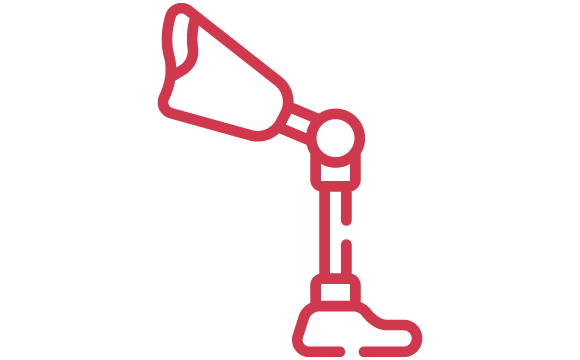Orthotics & Prosthetics
Orthotics and Prosthetics provide Rehabilitation services to persons with physical disabilities along with congenital deformities.
Some disabilities are caused by amputation where patients have lost part of their Lower and Upper limbs, whereas other disabilities are caused by conditions such as Poliomyelitis, Cerebral Palsy, Congenital Skeletal Limb deficiencies, and Spinal Cord Injury. Patients who have weak or deformed limbs or functional deficiencies due to the mentioned conditions are thereby unable to stand and walk properly and require Prosthetic and Orthotic aids and appliances. The department utilizes an assistive and corrective approach to deal with such patients.
The Department of Prosthetics and Orthotics designs fabricates and fits the latest and lightweight Prosthetic and Orthotic appliances to persons with disabilities utilizing the material according to defined standards. People lose limbs or suffer orthopedic impairment for many reasons, including accidents, combat injuries, birth defects, and disease. Health care workers who specialize in orthotics and prosthetics (O&P) help these patients regain their mobility by fitting them with artificial limbs (Prostheses) and orthopedic braces (Orthosis). At the highest level, O&P practitioners perform a detailed assessment to determine the patient’s O&P needs and assess the patient’s functional status, including muscle development, sensory function, range of motion, joint stability, and skin integrity.
O&P Practitioners also:
- Develop a plan that addresses the patients’ needs and goals, including pain reduction, comfort, stability, and mobility, as well as aesthetics.
- Select the appropriate design, materials, and components for optimum strength, durability, and function.
- Discuss the treatment plan, including benefits, risks, and time involved.
- Prepare the patient for the device, with the use of splints if needed.
- Take measurements, make impressions, and develop templates as needed to accurately fit the device.
- Fabricate/assemble the device and assess and properly align it for maximum function and comfort.
- Explain how to use and maintain the device.
- Provide ongoing care, including evaluation and modification of the device for optimal fit and function.
The type of aids and appliances provided at the NWGH O&P department are:
- Lower and Upper extremity Orthosis for supporting weak or deformed limb, to prevent or correct deformity
- Spinal Orthosis to support or immobilize the spine to relieve the pain, to prevent deformity, and facilitate postoperative desired outcomes.
- Lower and upper limb prosthesis (artificial limbs) to restore function and cosmetic appearance
- Prefabricated aids/ appliances for support and mobility



